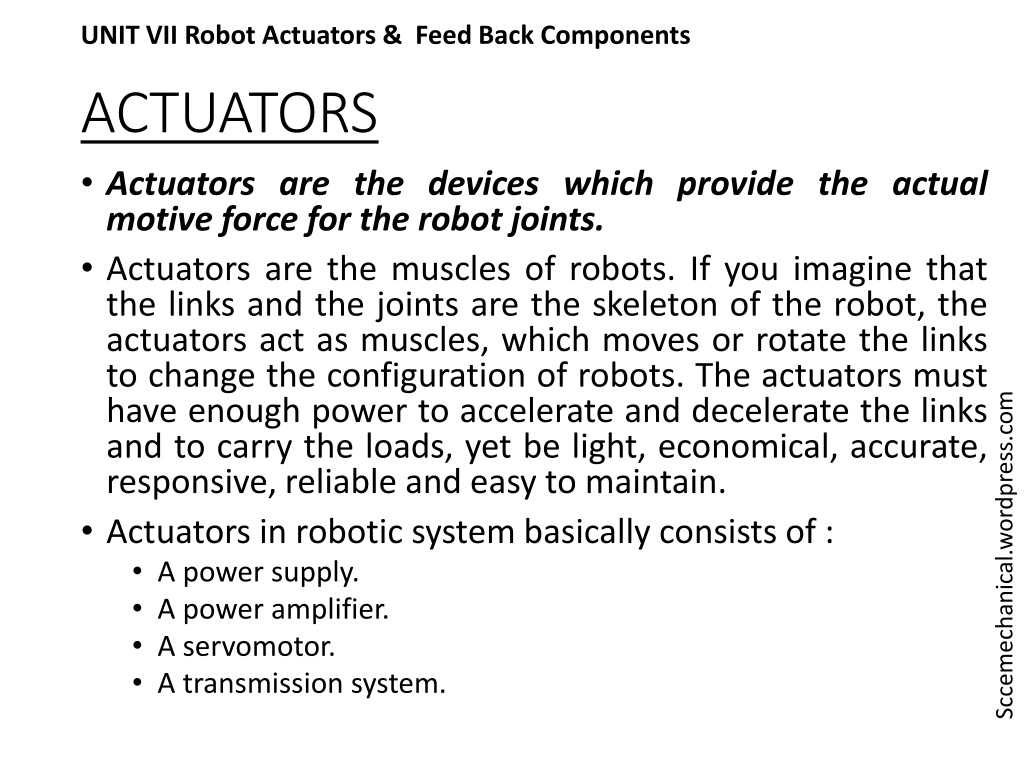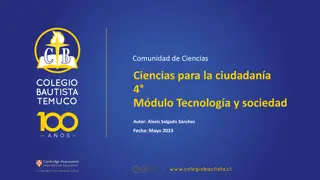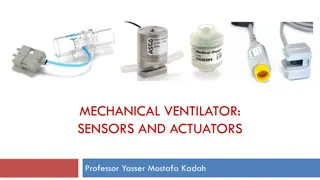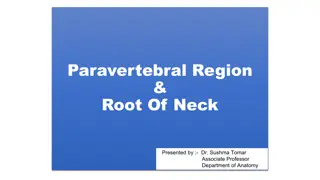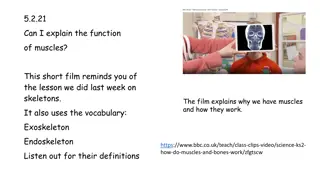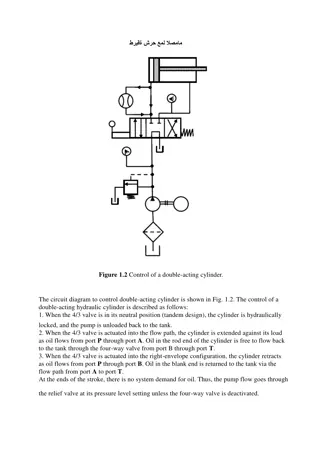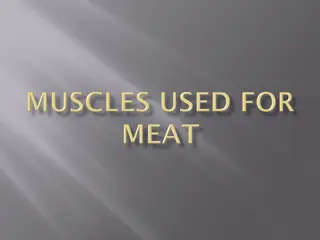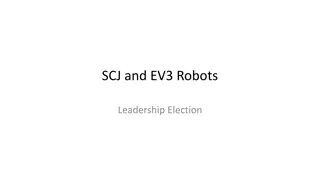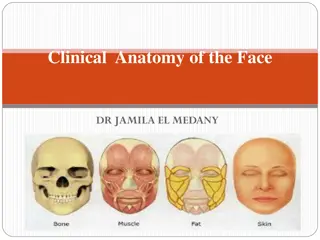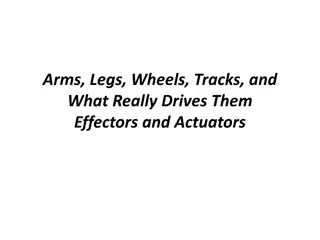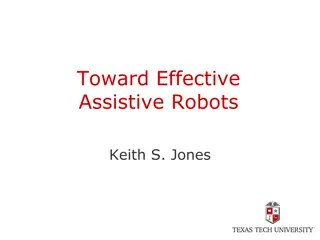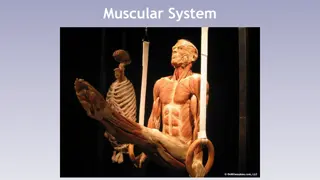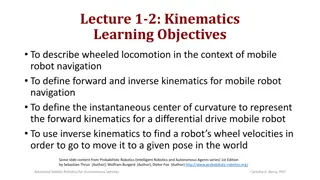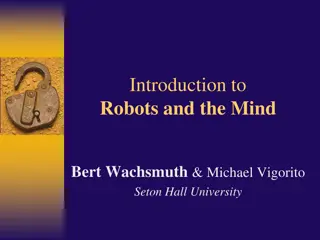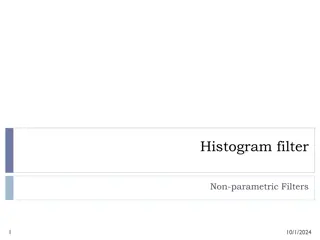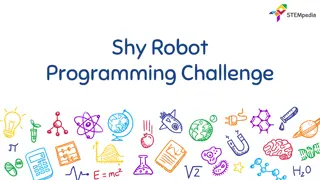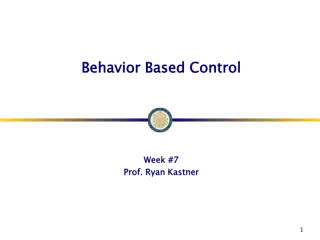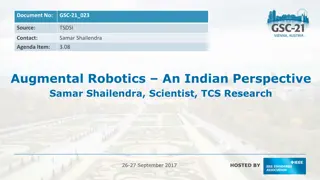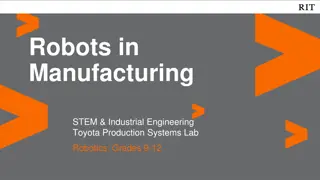Understanding Robot Actuators: The Muscles of Robots
Actuators are essential devices in robotics that provide the motive force for robot joints, functioning as the muscles of robots. They must be powerful, lightweight, accurate, reliable, and easy to maintain to effectively control the movement and configuration of robots. Actuators come in various types such as pneumatic, hydraulic, and electric, each utilizing different sources of input power to enable movement in robots.
Download Presentation

Please find below an Image/Link to download the presentation.
The content on the website is provided AS IS for your information and personal use only. It may not be sold, licensed, or shared on other websites without obtaining consent from the author. Download presentation by click this link. If you encounter any issues during the download, it is possible that the publisher has removed the file from their server.
E N D
Presentation Transcript
UNIT VII Robot Actuators & Feed Back Components ACTUATORS Actuators are the devices which provide the actual motive force for the robot joints. Actuators are the muscles of robots. If you imagine that the links and the joints are the skeleton of the robot, the actuators act as muscles, which moves or rotate the links to change the configuration of robots. The actuators must have enough power to accelerate and decelerate the links and to carry the loads, yet be light, economical, accurate, responsive, reliable and easy to maintain. Actuators in robotic system basically consists of : A power supply. A power amplifier. A servomotor. A transmission system. Sccemechanical.wordpress.com
UNIT VII Robot Actuators & Feed Back Components Actuator system Actuator system Pp : Primary source of power (Electric, Press.fluid, compress. Air) Pc : Input control power usually electric . Pa : Input power to motor Electric, Hydraulic, or Pneumatic. Pm: Power output from motor. Pu : mechanical power required POWER SUPPLIES PP MOTOR OR SERVO MOTOR Pu Pa Pm POWER AMPLIFIER Pc TRANSMISSION Sccemechanical.wordpress.com Pdt Pda Pds Pds, Pdt , Pda : Powers lost in dissipation for the conversion performed by the Amplifier, Motor, Transmission
UNIT VII Robot Actuators & Feed Back Components ISSUES/CHARACTERISTICS OF AN ISSUES/CHARACTERISTICS OF AN ACTUATOR ACTUATOR Load (e.g. torque to overcome own inertia) Speed (fast enough but not too fast) Accuracy (will it move to where you want?) Resolution (can you specify exactly where?) Repeatability (will it do this every time?) Reliability (mean time between failures) Power consumption (how to feed it) Energy supply & its weight. Sccemechanical.wordpress.com
UNIT VII Robot Actuators & Feed Back Components TYPES OF ACTUATORS TYPES OF ACTUATORS Based on the source of Input Power actuators are classified in to three groups : 1. Pneumatic Actuators. These utilize pneumatic energy provided by the compressor and transforms it into mechanical energy by means of pistons or turbines. 2. Hydraulic Actuators. These Transform the energy stored in reservoir into mechanical energy by means of suitable pumps. 3. Electric Actuators. Electric actuators are simply electro-mechanical devices which allow movement through the use of an electrically controlled systems of gears Sccemechanical.wordpress.com
UNIT VII Robot Actuators & Feed Back Components Pneumatic Pneumatic and Both these actuators are powered by moving fluids. In the first case, the fluid is compressed air and In the second case, the fluid is pressurized oil. Pneumatic systems typically operate at about 100lb/in2 Hydraulic systems at 1000 to 3000 lb/in2. Both Hydraulic and Pneumatic actuators are classified as linear Actuators (Cylinders). Rotary Actuators (Motors). and Hydraulic Hydraulic Actuators Actuators Sccemechanical.wordpress.com
UNIT VII Robot Actuators & Feed Back Components Pneumatic Pneumatic and linear Actuators and Hydraulic Hydraulic Actuators Actuators Sccemechanical.wordpress.com
UNIT VII Robot Actuators & Feed Back Components Pneumatic Pneumatic and linear Actuators and Hydraulic Hydraulic Actuators Actuators The simplest power device could be used to actuate a linear joint by means of a moving piston. There are two relationships of particular interest when discussing actuators: 1. The velocity of the actuator with respect to input power and 2. Force of the actuator with respect to the input power. Sccemechanical.wordpress.com
UNIT VII Robot Actuators & Feed Back Components Pneumatic Pneumatic and linear Actuators and Hydraulic Hydraulic Actuators Actuators Sccemechanical.wordpress.com
UNIT VII Robot Actuators & Feed Back Components Pneumatic Pneumatic and Rotary Actuators and Hydraulic Hydraulic Actuators Actuators Sccemechanical.wordpress.com
Pneumatic Pneumatic and Rotary Actuators and Hydraulic Hydraulic Actuators Actuators There is a relationship of particular interest when discussing Rotary actuator: The angular velocity, , and Torque, T. Sccemechanical.wordpress.com R, outer radius of the vane., r, inner radius., h, thickness of the vane., , angular velocity., T, torque.
UNIT VII Robot Actuators & Feed Back Components Advantages and limitations of Advantages and limitations of Pneumatic actuators Pneumatic actuators ADVANTAGES LIMITATIONS It is cheapest form of all actuators. Components are readily available and compressed air normally is an readily available facility in factories. Compressed air can be stored and conveyed easily over long distances. They have few moving parts making them inherently reliable and reducing maintenance costs. They have quick action and response time thus allowing for fast work cycles. No mechanical transmission is usually required. These systems are usually compact thus the control is simple e.g: mechanical stops are often used. Since air is compressible, precise control of speed and position is not easily obtainable unless much more complex electro mechanical incorporated in to system. If mechanical stops are used resetting the system can be slow. If moisture penetrates the units and ferrous metals have been used then damage to individual components may happen. devices are Sccemechanical.wordpress.com
UNIT VII Robot Actuators & Feed Back Components Advantages and limitations of Advantages and limitations of Hydraulic actuators Hydraulic actuators ADVANTAGES LIMITATIONS Leakages can occur causing a loss in performance and general contamination of the work area. There is also a higher fire risk. The power pack can be noisy typically about 70 decibel or louder if not protected by an acoustic muffler. Changes in temp alter the viscosity of hydraulic fluid. Thus at low temperatures viscosity will increase possibly causing sluggish movement of the robot. High efficiency and high power to size ratio. Complete and accurate control over speed position and direction of actuators are possible. No mechanical linkage is required i.e., a direct drive is obtained with mechanical simplicity. They generally have a greater load carrying capacity than electric and pneumatic actuators. Self lubricating and non corrosive. Hydraulic robots are more capable of with standing shock loads than electric robots. Sccemechanical.wordpress.com fluid
UNIT VII Robot Actuators & Feed Back Components Electric Electric and and Stepper Stepper Motors Motors There are a variety of types of motors used in robots. The most common types are Servomotors and Stepper motors. Electric actuators mechanical devices which allow movement through the use of an electrically controlled systems of gear. are simply electro- Sccemechanical.wordpress.com
ELECTRIC MOTORS ELECTRIC MOTORS Electric motors usually have a small rating, ranging up to a few horsepower. They are used in small appliances, battery operated vehicles, for medical purposes and in other medical equipment like x-ray machines. Electric motors are also used in toys, and in automobiles as auxiliary motors for the purposes of seat windows, sunroof, blower motors, engine cooling fans. Sccemechanical.wordpress.com adjustment, mirror power adjustment,
UNIT VII Robot Actuators & Feed Back Components STATOR ROTATING (COMMUTATOR) ARMATURE Sccemechanical.wordpress.com Brushes
UNIT VII Robot Actuators & Feed Back Components COMPONENTS COMPONENTS OF OF DC DC ELECTRIC ELECTRIC MOTOR MOTOR The principle components of an electric motor are: North and south magnetic poles to provide a strong magnetic field. Being made of bulky ferrous material they traditionally form the outer casing of the motor and collectively form the stator. Anarmature, which is a cylindrical ferrous core rotating within the stator and carries a large number of windings made from one or more conductors. Acommutator, which rotates with the armature and consists of copper contacts attached to the end of the windings. Brushes in fixed positions and in contact with the rotating commutator contacts. They carry direct current to the coils, resulting in the required motion. Sccemechanical.wordpress.com
ELECTRIC MOTORS ELECTRIC MOTORS DC motors :In DC motors, the stator is a set of fixed permanent magnets, creating a fixed magnetic field, while the rotor carries a current. Through brushes and commutators, the direction of current is changed continuously, causing the rotor to rotate continuously. AC motors : These are similar to DC motors except that the rotor is permanent magnet, the stator houses the windings, and all commutators and brushes are eliminated. A Servomotor is a DC,AC, brushless, or even stepper motor with feedback that can be controlled to move at a desired speed (and consequently, torque), for a desired angle of rotation. To do this, a feedback device sends signals to the controller circuit of the servomotor reporting its angular position and velocity. Sccemechanical.wordpress.com
UNIT VII Robot Actuators & Feed Back Components COMPONENTS COMPONENTS OF OF DC DC ELECTRIC ELECTRIC MOTOR MOTOR A A simple simple DC generated generated around from from the the left continues to rotate, When commutator commutator reverses reverses the magnetic magnetic field field. . The DC electric electric motor around the the armature left magnet magnet and motor: : when armature. . The and drawn drawn toward When the the direction direction of of current The process process then then repeats when the The left toward the the armature armature becomes current through repeats. . the coil left side the right, coil is is powered, powered, a a magnetic side of of the the armature armature is is pushed right, causing causing rotation rotation. . The armature becomes horizontally horizontally aligned, through the the coil, magnetic field pushed away field is is away aligned, the reversing the the the coil, reversing Sccemechanical.wordpress.com
UNIT VII Robot Actuators & Feed Back Components Sccemechanical.wordpress.com
UNIT VII Robot Actuators & Feed Back Components STEPPER MOTOR STEPPER MOTOR When incremental rotary motion is required in a robot, it is possible to use stepper motors. A stepper motor possesses the ability to move a specified number of revolutions or fraction of a revolution in order to achieve a fixed and consistent angular movement. This is achieved by increasing the numbers of poles on both rotor and stator Additionally, soft magnetic material with many teeth on the rotor and stator cheaply multiplies the number of poles(reluctance motor) Sccemechanical.wordpress.com
UNIT VII Robot Actuators & Feed Back Components STEPPER MOTOR STEPPER MOTOR Sccemechanical.wordpress.com
UNIT VII Robot Actuators & Feed Back Components ADVANTAGES & LIMITATIONS OF ADVANTAGES & LIMITATIONS OF ELECTRIC ELECTRIC ACTUATORS ACTUATORS ADVANTAGES LIMITATIONS Electric actuators often require some sort transmission increases the movement, additional power and may complicate control. Due to increased complexity of the transmission additional cost is incurred for their procurement maintenance. Electric motors intrinsically safe. They cannot therefore be used in for example atmospheres. Wide spread availability of power supply. The basic dive element in an electric motor is usually lighter than that for fluid power. High power conversion efficiency. No pollution of working environment The accuracy and repeatability of electric power driven robots are normally better than fluid power robots in relation to cost. Easily maintained and repaired. The drive system is well suited to electronic control. of mechanical system unwanted this Sccemechanical.wordpress.com system and are not explosive
UNIT VII Robot Actuators & Feed Back Components APPLICATIONS APPLICATIONS Stepper motors can be a good choice whenever controlled movement is required. They can be used to advantage in applications where you need to control rotation angle, speed, position and synchronism. These include : printers plotters medical equipment fax machines automotive and scientific equipment etc. Sccemechanical.wordpress.com
UNIT VII Robot Actuators & Feed Back Components Comparison of actuating systems Comparison of actuating systems Electric Hydraulic Pneumatic + Good for large robots + Many components are + Good for all size of and heavy payload usually off-the-shelf Robots +Highest Power/Weight +Reliable components. +Better control, good for Ratio high precision robots +No leaks or sparks +Stiff system, High +Higher Compliance that Sccemechanical.wordpress.com accuracy, better response Hydraulics +Inexpensive and simple +No reduction gear +Reduction gears used needed reduce inertia on the +Low pressure compared +Can work in wide range motor to hydraulics of speeds without +does not leak, good for difficulty clean room + Good for on-off +Can be left in position applications and for pick +Reliable, low without any damage and place maintenance
UNIT VII Robot Actuators & Feed Back Components Comparison of actuating systems Comparison of actuating systems Hydraulic Electric Pneumatic - May leak. Not fit for clean room application -Requires pump, reservoir, motor, hoses etc. -Can be expensive and noisy, requires maintenance. +Can be spark-free. Good for explosive environment. +Complaint systems. -Noisy systems. -Low stiffness -Needs reduction gears, increased backlash, cost, weight, etc. - Require air pressure, filter, etc. Sccemechanical.wordpress.com -Viscosity of oil changes with temperature -Difficult to control their linear position -Motor needs braking device when not powered. Otherwise, the arm will fail. -Very susceptible to dirt and other foreign material in oil -Low compliance -Deform under load constantly - -Very low stiffness. Inaccurate response. - -High torque, High pressure, large inertia on the actuator. - -Lowest power to weight ratio
